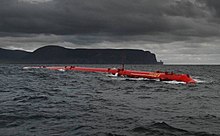Sea snake (wave power plant)

A sea snake ( Greek Pelamis ) is a design of wave power plants , the first prototype of which was put into operation in 2004 off the Scottish coast.
construction
They consist of several steel pipe segments that are coupled by joints. Hydraulic pumps that drive a generator are attached to the joints . Like wind energy parks, they can be used to generate renewable energies from the sea . The existing prototype is 150 meters long, consists of four segments, each 3.5 meters in diameter, and generates a maximum output of 750 kW. According to the manufacturer, only 25–40% of this value is achieved on an annual average. To avoid ecological risks, it must be ensured that the hydraulic fluid used is readily biodegradable.
With previous wave energy systems , a main problem was the robustness against " monster waves ". With the current design, this problem is to be circumvented by diving the float through waves that are too large .
Advantages over wind power plants
- no cranes required for installation
- no foundations required, just an anchor with chain
- Since waves occur at the edge of oceans even when there is no local wind, wave power plants can usefully complement the existing mix of renewable energies by reducing fluctuations in the total amount of energy generated
Decommissioned plants
Aguçadoura I Wave Farm (Portugal)
For many years the Scottish Pelamis Wave Power developed and operated a prototype with 750 kW output. An agreement was reached with the Portuguese company Enersie (later taken over by Babcock & Brown) to build the wave farm off the Portuguese west coast. In April 2006, three systems manufactured in Scotland arrived in pieces on a freighter in the port of Peniche (80 km north of Lisbon ). Commissioning and testing, however, took two and a half years. It was not until the summer of 2008 that the three systems, each with an output of 750 kW, were towed towards Porto. At Póvoa de Varzim they were anchored 5 km off the coast in 40 m water depth. The plant with the number 002 then went into operation on July 15, 2008 and fed the first electricity into the Portuguese grid. On September 24, 2008, the entire wave farm was inaugurated by the Portuguese Minister of Economic Affairs.
Half a year later, however, the three plants were stopped due to technical and financial problems and towed to the port of Porto. There is currently no information on recommissioning.
The "WaveRoller" wave power plant works on a completely different principle. It is currently in test operation north of Peniche off Portugal.
Aguçadoura II
Aguçadoura II should go into operation next before Portugal. After initially planning to install 34 systems, there were then 25 systems with a total output of 18.75 MW. The cost was estimated at around 70 million euros.
Westwave
15 km from Hayle ( Great Britain , north coast of Cornwall ), 7 plants with a total of 5 MW, completion 2009.
Plants in planning
A model whose float consists mainly of rubber-like material is called an anaconda and is in the research and planning phase.
Web links
- Stream from the sea serpent. energieportal24.de
- Website of the manufacturer ( Memento of December 21, 2014 in the Internet Archive ) (English)
- Agucadoura Farm Gallery ( Memento from May 16, 2010 in the Internet Archive )
- Pelamis on the cusp of commercialization? Telepolis
- Article on Anaconda wave power plants. New Scientist , July 4, 2008 (English)
Individual evidence
- ↑ Article on Anaconda wave power plants. New Scientist , July 4, 2008 (English)
- ↑ Another article on this at Renewable Energy World (July 15, 2008)

